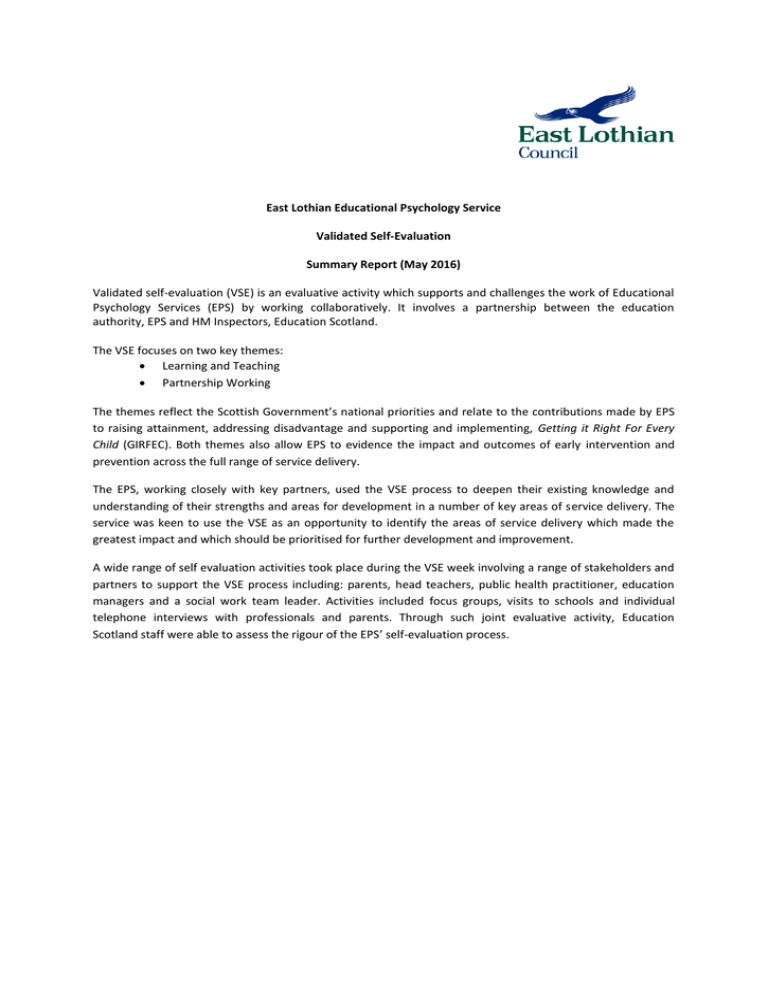East Lothian Educational Psychology Service Validated Self
advertisement

East Lothian Educational Psychology Service Validated Self-Evaluation Summary Report (May 2016) Validated self-evaluation (VSE) is an evaluative activity which supports and challenges the work of Educational Psychology Services (EPS) by working collaboratively. It involves a partnership between the education authority, EPS and HM Inspectors, Education Scotland. The VSE focuses on two key themes: Learning and Teaching Partnership Working The themes reflect the Scottish Government’s national priorities and relate to the contributions made by EPS to raising attainment, addressing disadvantage and supporting and implementing, Getting it Right For Every Child (GIRFEC). Both themes also allow EPS to evidence the impact and outcomes of early intervention and prevention across the full range of service delivery. The EPS, working closely with key partners, used the VSE process to deepen their existing knowledge and understanding of their strengths and areas for development in a number of key areas of service delivery. The service was keen to use the VSE as an opportunity to identify the areas of service delivery which made the greatest impact and which should be prioritised for further development and improvement. A wide range of self evaluation activities took place during the VSE week involving a range of stakeholders and partners to support the VSE process including: parents, head teachers, public health practitioner, education managers and a social work team leader. Activities included focus groups, visits to schools and individual telephone interviews with professionals and parents. Through such joint evaluative activity, Education Scotland staff were able to assess the rigour of the EPS’ self-evaluation process. National Theme 1– Teaching & Learning How effective is East Lothian EPS in building capacity of schools to enhance teaching and learning? The focus of activities with regard to the Learning and Teaching theme included: Investigating and identifying key factors for building capacity across the core roles (this topic was chosen to drill down on what to prioritise with competing demands of time). Scrutiny of evaluation data already gathered in relation to school questionnaires, case work and training evaluation to consider evidence: are we effectively building capacity? Are our evaluation processes fit for purpose? Is there evidence of long-term impact? Longitudinal follow-up re a range of training topics (mindset, attachment, Autism Spectrum Disorder) to consider how we embed long-term evaluation and follow-up in order to consider the long-term impact of our work. Drilling down further on key factors for building capacity via an example of use of Educational Psychologist (EP) in school development work and follow-up. This allowed us to reflect on an effective model for service delivery and how to gather evidence of impact on learning and teaching. Strengths Trusting relationships between schools and the link EP was a consistent and high level message. Their understanding of cases and the school context increased the effectiveness of embedding practice, for instance, following training. Learning and development work within schools and across the Authority in a range of topics is highly valued and based on a needs analysis at the school level. Evidence of training becoming higher priority as a core role. Knowing the school context, EPs relate this to case level work and embed practice via the on-going role in the school. Assessment (e.g. observations, Cognitive Abilities Profile, dynamic assessment) /intervention/consultation in relation to children and young people’s additional support needs with recommendations providing strategies and curricular adaptations that lead to improved outcomes. Case work and consultation builds capacity and evidence of reduced need for EPs to attend Staged Assessment and Intervention meetings. Graphic facilitation was particularly mentioned as up-skilling Senior Management Team to manage meetings more effectively. Use of evidence based practice and Implementation Science to support school development e.g. Nurture Groups. Attachment Aware Communities – building capacity in schools to understand the needs of young people with attachment difficulties and settle them to learn. Clear evidence of impact/outcomes included increased inclusion, children more settled, improved staff well-being and lower exclusions. Evidence of EP’s contribution maintaining mainstream placement. Areas for Improvement Review service delivery model to ensure the most efficient, effective and sustainable Service delivery to support local and national priorities. Schools value time allocation with flexibility. Consider linking with cluster planning/cluster data and School Improvement Plans in April/May to prioritise systemic and development work which builds capacity and ensures a balance of work across the core roles. Training and development work. Consider use of Request for Assistance (other documents) for this so there is a needs analysis and it considers school readiness. Link skills across the team and schools to share expertise and build the capacity of EPS. Ensure EP role in strategic implementation e.g. GIRFEC. Promote use of graphic and Person Centred Planning to support meeting management in Child’s Planning process. Request for Assistance – how can we be more explicit at supporting schools to use this dynamically and reflectively to help develop Practitioner Enquiry skills. Review self-evaluation policy and develop systems for embedding longitudinal evaluations. Plan intended outcomes/impact in advance across the core roles to further embed self-evaluation into everyday practice. National Theme 2 – Partnership Working Where does the EPS work effectively with partners to improve outcomes for children and young people? The focus of activities with regard to the Partnership Working theme included: The EPS contribution to the Early Years. What it looks like currently; how it impacts on children and young people and how we can improve it. The multi-disciplinary work that the EPS engages in including our contribution to Staged Assessment and Intervention, strategic planning groups and Authority processes. Our collaborative work with our school partners including reviewing our revised Service Level Agreements and new Request for Assistance procedures. Looking at our role in supporting children and young people in out-with placements through semistructured interviews with key partners. Strengths: Strong and supportive relationships with our partners, including schools – both within and outwith the authority, parents and other agencies. This was highlighted by school staff who found this support enabled them to manage challenge and build capacity. The ability to be part of any team and work collaboratively and take an objective and reflective stance was highly valued. This includes presenting as an accessible and responsive Service. The capacity to use our unique psychological skills and knowledge to build a holistic, contextualised picture of the children/ young person and then distil the information down to identify how an individual’s needs can be met. All partners find this contribution helpful. Training was valued, particularly when knowledge of the school is used to create an individually tailored programme. This includes embedding the work through further development within the school or partner agencies to build capacity. The collaborative approach including using the “Plan, Do, Review” framework was valued by schools and partner agencies. It supported partners to think in a reflective and focused manner and helped create more consistency of practice. Areas for Improvement: Using the EPS time most effectively by reducing the time spent contributing to resource allocation processes and focus this time on capacity building across the 5 core functions – consultation, assessment, intervention, training and research. Developing the EPS role in the Early Years in relation to planning, research, strategic implementation, equity of access and early intervention and prevention. Continue to contribute and explore further how we can most effectively contribute to the implementation of the Children and Young People’s Act. e.g. through the use of graphic facilitation within the Child’s Plan. Promoting and sharing widely our knowledge on research and how this can be applied within different contexts. Review our Service delivery model with partners to consider our role in universal and targeted services.


